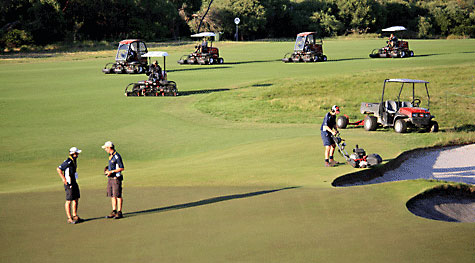|
Royal Melbourne...
Michael Stachowicz, Dedham Country and Polo Club, Dedham, MA:

"Royal Melbourne's greens were the talk of the golf community during the President's Cup. They were touting what is called 'Sutton's Mix', the bent grass mix that Royal Melbourne was seeded to over 100 years ago.
Sutton's Mix is very similar to South German Mix which Dedham's greens were seeded to. They both are a mix of colonial bentgrass (browntop), creeping bentgrass, and velvet bentgrass. This mix leads to a patchy appearance and the infiltration of poa leads to a spotty appearance. Here at Dedham we have been working to reduce the spotty appearance by steering our practices to encourage bent over poa. Some of our best greens have pretty much completed that transformation like 4, 7, 9, 12, 15 and 17. We are also doing this for health... sustainable health.

About 10 years ago Royal Melbourne was all poa... a fertilizer- and water-loving grass that is very disease prone. Nothing is better than a poa surface to putt on when it is good, but when it seeds or gets disease or winter kill, it is a disaster. Poa is a very weak plant that cannot provide consistent conditioning. Then Australia went through a major drought in the mid-aughts and poa was no longer a viable turf.
Royal Melbourne tried some of the new varieties of creeping bent. When they did not perform at the level that was good for them, they pulled samples of Sutton's Mix bents from some small patches that remained in their other greens, grew them out until they seeded, and harvested the seed. After a few years, this generated enough seed and seed bearing plants to seed their greens back to Sutton's Mix.
"Now, that doesn't explain the purplish appearance of the greens; the fertility program does..." |
Now, that doesn't explain the purplish appearance of the greens; the fertility program does. Royal Melbourne is so committed to keeping poa out, having consistent roll, and good firmness that they have adopted a fertility program that turns their greens this color. The color is mostly generated by high rate applications of iron sulfate. This is part of a program that lowers the pH of the soil to inhibit weed infiltration, including poa, and changes the growth habit of the actual turf blade making it thinner, more bristly.
Here at Dedham, we have been using acidic fertilizers for the same purpose, just not at the extreme they are. We have successfully used this approach to rid the fairways of poa, and we have reduced the spottiness on the greens from poa. We are progressing more slowly so as not to disrupt the course.
All of this falls under the heading 'All that is old is new again'... Acid theory and South German bent varieties are part of greenkeeping history and have value today."
Visit Michael's blog at mstachowicz.wordpress.com.
|